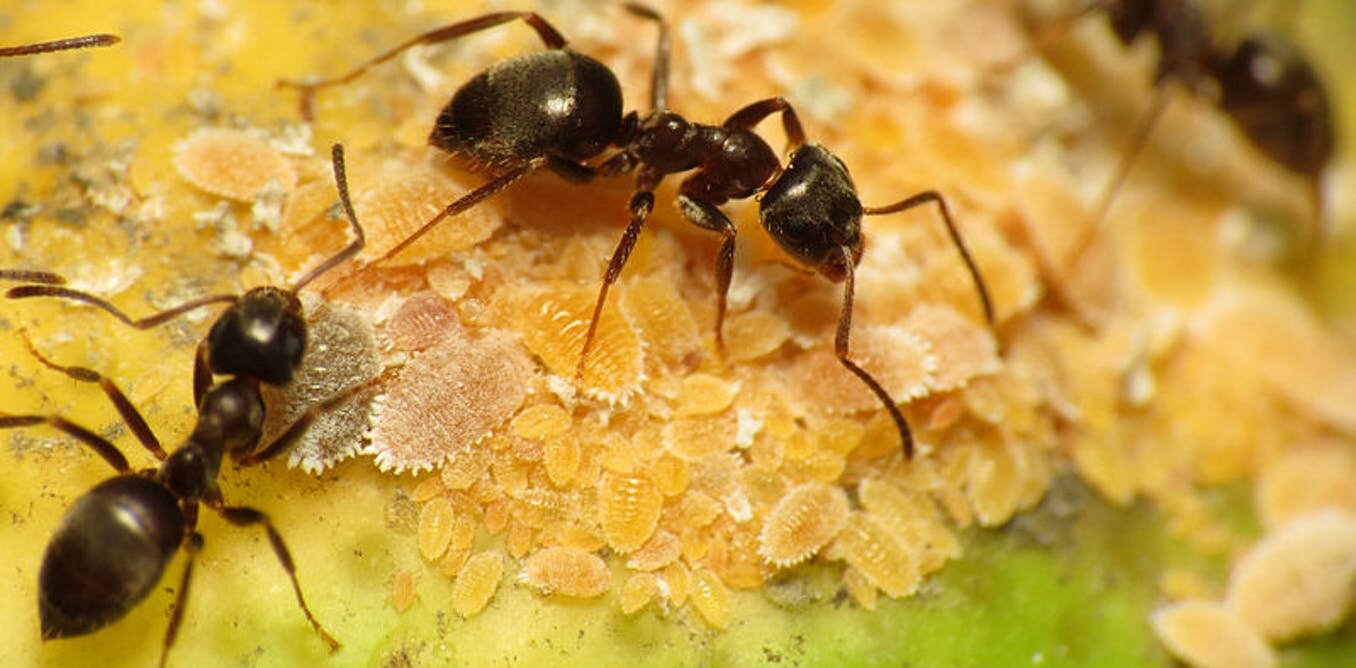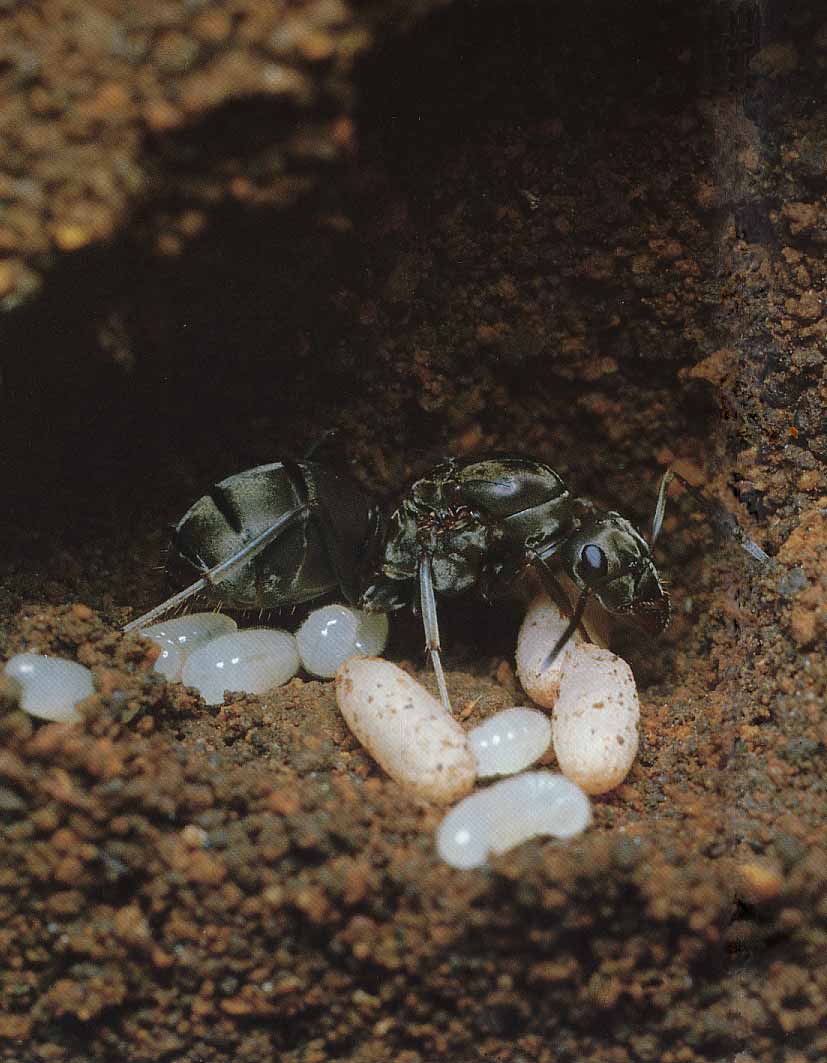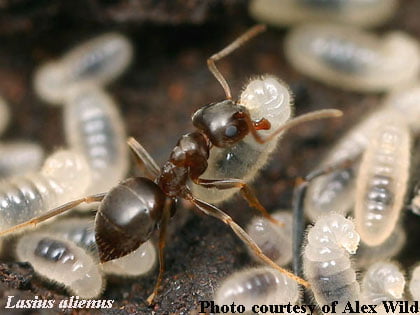The queen ant lays eggs. The species varies, and different types of ants have different egg-laying behaviors.
Ants are social insects that belong to the family Formicidae. With over 12,000 known ant species, they are found on every continent except Antarctica. Ants play a crucial role in ecosystems as scavengers and seed dispersers, influencing soil conditions and plant growth.
The ant colony is usually divided into castes, with the queen responsible for laying eggs and the worker ants caring for the young and maintaining the nest. Understanding which ant species lays eggs is essential to comprehending their life cycle and behavior, as well as aiding in pest control and biodiversity conservation efforts.
Ant Reproduction
Queen Ants
Queen ants are the key to the reproduction process in an ant colony.
Mating
Ant mating occurs during a nuptial flight where male and female ants swarm.
Egg-laying
After mating, the queen ant starts egg-laying to expand the colony’s population.

Credit: www.newscientist.com
Egg-laying In Different Ant Species
Egg-laying in different ant species is a fascinating aspect of their lifecycle. Each ant species has its own unique behaviors and strategies when it comes to reproduction. Let’s take a closer look at the egg-laying habits of some commonly found ant species.
Carpenter Ants
Carpenter ants, commonly found in wooded areas, lay eggs in the moist wood where they create galleries. The queen is responsible for laying eggs, which are tended to by the worker ants. These eggs hatch into larvae, which are then cared for within the colony.
Fire Ants
Fire ants, known for their aggressive behavior, usually lay eggs in large underground colonies. The queen fire ant can lay up to 1,500 eggs per day. The eggs are maintained and protected by the worker ants until they hatch into pupae. This species exhibits a high level of reproductive efficiency.
Leafcutter Ants
Leafcutter ants are notable for their farming behavior. The queen leafcutter ant lays eggs within the underground chambers. The eggs are then cultivated by the workers, who use leaves to create a fungus that serves as food for the colony. Leafcutter ants demonstrate a sophisticated method of egg-laying and colony sustenance.
The Queen’s Role In Egg-laying
Ants are a fascinating species, with a complex social structure revolving around the role of the queen. The queen ant plays a crucial role in the egg-laying process within the colony. Understanding the queen’s anatomy and fertility provides insight into the remarkable nature of their reproductive capabilities.
Queen’s Anatomy
The queen ant possesses a specialized anatomy that enables her to fulfill her reproductive duties. With a developed ovaries and a unique reproductive system, the queen is equipped to lay eggs continually, ensuring the growth and sustainability of the colony.
Queen’s Fertility
The queen ant’s fertility is a remarkable aspect of her role in the colony. Capable of producing a vast number of eggs throughout her lifespan, the queen maintains the population and fosters the expansion of the ant community. Her fertility is essential in sustaining the existence of the colony.
Development Of Ant Eggs
Ant eggs go through a fascinating process of development before transforming into adult ants. Understanding the incubation period and the arrangement of egg clusters can shed light on the intricate journey of ant reproduction.
Incubation Period
Ant eggs typically have a short incubation period, usually lasting between 8 to 10 days.
Egg Clusters
Ant eggs are commonly grouped together in egg clusters, which are carefully tended to by worker ants to ensure proper development.
Factors Affecting Egg-laying
When it comes to ant colonies, the process of egg-laying plays a crucial role in the growth and survival of the colony. Understanding the factors that influence egg-laying can provide valuable insights into the behavior and dynamics of ant populations. In this article, we will explore three key factors that affect egg-laying in ants: environment, nutrition, and the queen’s age.
Environment
An ant’s environment plays a significant role in determining its reproductive behavior. Ants are well-known for their ability to adapt to different habitats and climates. The temperature, humidity, and overall conditions of the environment can directly impact an ant’s ability to lay eggs. For instance, certain species of ants have specific temperature requirements for successful egg development. If the temperature falls below or exceeds the optimal range, it can affect the ant’s reproductive capabilities. Additionally, factors such as light exposure, presence of predators, and availability of suitable nesting sites can also influence egg-laying behavior.
Nutrition
The nutritional status of ants is another critical factor that affects egg-laying. Just like any other living organism, ants require proper nutrition to reproduce efficiently. The availability and quality of food sources influence the egg-laying capacity of ants. A well-rounded diet consisting of carbohydrates, proteins, fats, and essential nutrients is essential for healthy egg production. Inadequate nutrition can hinder an ant’s ability to create viable eggs and sustain a growing colony. Furthermore, some studies suggest that the presence of specific nutrients like omega-3 fatty acids can enhance the reproductive capabilities of ants.
Queen’s Age
Among ants, the queen holds the highest importance in egg-laying. The age of the queen plays a significant role in determining the quantity and quality of eggs produced. As the queen ages, her egg-laying capacity gradually decreases. Generally, younger queens have higher fertility and can lay more eggs compared to older queens. However, it’s important to note that the queen’s age alone does not solely dictate her egg-laying abilities. The queen’s overall health, genetic factors, and environmental cues also influence her egg production. Therefore, maintaining a healthy and young queen is crucial for ensuring a thriving ant colony.

Credit: phys.org
Challenges And Threats To Ant Eggs
Ant eggs play a crucial role in the survival and growth of ant colonies, but these fragile structures are not without their challenges and threats. Just like any other species, ant eggs face a range of dangers, both from predators and environmental factors. Understanding these challenges can shed light on the remarkable adaptations and strategies that ants employ to protect their eggs and ensure the survival of their colonies.
Predators
Ant eggs are a valuable source of nutrition for a variety of predators. Many animals, including insects and birds, see ant eggs as a tasty and easy-to-obtain meal. Some common predators of ant eggs include:
- Spiders
- Beetles
- Antlions
- Some species of ants
These predators use different techniques to locate and access ant eggs. For example, spiders often build their webs near ant colonies to catch unsuspecting ants and their eggs. Similarly, certain species of beetles have evolved to mimic ant pheromones, allowing them to infiltrate ant nests and feast on the eggs.
Parasites
In addition to predators, ant eggs are also at risk of parasitic attack. Some species of parasitic insects and mites have developed intricate strategies to exploit ant colonies and their precious eggs. These parasites lay their own eggs alongside or inside ant eggs, taking advantage of the ants’ nurturing behavior to raise their own offspring. Once hatched, the parasite’s larvae feed on the ant eggs, undermining the colony’s reproduction efforts. Some common ant egg parasites include:
- Strepsipterans
- Braconid wasps
- Phorid flies
- Acari mites
These parasitic organisms have evolved remarkable adaptations to infiltrate ant colonies and evade detection. For example, some braconid wasps release chemicals that mimic the pheromones of the host ant species, tricking the ants into caring for and protecting the wasp eggs, unaware of their true nature.
Environmental Factors
In addition to predators and parasites, ant eggs also face challenges from various environmental factors. Factors such as temperature, humidity, and exposure to harmful substances can all have a detrimental impact on the development and survival of ant eggs. Some key environmental threats to ant eggs include:
| Environmental Factor | Impact on Ant Eggs |
|---|---|
| Extreme temperatures | Affect egg development and viability |
| Excessive moisture | Promotes fungal growth which can infect and kill eggs |
| Predator presence near the nest | Increases the likelihood of egg predation |
| Exposure to toxic chemicals | Can lead to egg mortality |
Ants have evolved various strategies to mitigate the impact of these environmental challenges. For example, some species of ants construct intricate nests that regulate temperature and humidity levels, providing a suitable environment for egg development. Additionally, ants may employ chemical defenses to repel predators or remove contaminated eggs from the nest.

Credit: ant.miyakyo-u.ac.jp
Frequently Asked Questions Of Which Ant Lays Eggs
What Type Of Ant Lays Eggs?
Ants belonging to the species Formica, Myrmica, and Lasius are known to lay eggs. These ants are commonly found in many regions and are capable of creating large colonies. They have a complex social hierarchy and the queen ant is responsible for laying eggs to ensure the survival of the colony.
How Do Ants Lay Their Eggs?
Ants lay their eggs through a process called oviposition. The queen ant possesses an ovipositor, a tube-like structure through which she releases eggs. The eggs are usually small and oval-shaped. The queen carefully chooses the location where she deposits the eggs, typically in a protected and secure area of the ant colony.
Can All Ants Lay Eggs?
No, not all ants have the ability to lay eggs. In an ant colony, there is usually only one queen ant who is responsible for egg-laying. The rest of the ants in the colony, known as worker ants, are sterile females who are tasked with various responsibilities, such as foraging for food, caring for the larvae, and protecting the colony.
Conclusion
Discovering which ant lays eggs is fascinating. Understanding their life cycle helps in pest control. Remember, different ant species have unique behaviors. Observing their habits can lead to valuable insights. By learning more about ants, we can coexist peacefully with these tiny yet remarkable creatures.

I’m MD Tanvir, and I bring years of expertise gained from working closely with pest control companies to the forefront. My journey in the industry has inspired me to launch Bug Battler, a platform aimed at equipping people with the know-how to combat pests autonomously. Through Bug Battler, I aim to empower individuals with practical insights to tackle pest infestations effectively.

